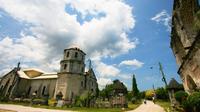Small-Group Cebu City Afternoon Fun Tour by Coach
Cebu City, Philippines
Rating: 





Trip Type: Bus & Minivan Tours
Duration: 4 hours
This afternoon Cebu city tour includes guide and visits to some of Cebu's most famous landmarks. View important areas such as Taoist Temple and Cebu Provincial Capitol Hall. See the sights in one fun-filled trip!
More About This Activity All Bus & Minivan Tours →
This afternoon Cebu city tour includes guide and visits to some of Cebu's most famous landmarks. View important areas such as Taoist Temple and Cebu Provincial Capitol Hall. See the sights in one fun-filled trip!
Taoist Temple
This temple preserves the teachings of Lao-Tse, the 600 B.C. Chinese philosopher. Everyday people climb its 99 steps to light joss sticks and have their fortune read. A towering, multi-tiered, multi-hued attraction accessible by three separate winding routes.Attractions here consist of huge, colorful dragon, a replica of the Great Wall of China, spacious balconies offering scenic views, souvenir shops, mini library with instructional materials, and dozens of escalating steps.
Cebu Provincial Capitol Hall (Running Tour)
The provincial government of then Governor Sotero B. Cabahug in 1937 started the construction of the Capitol during that year and then inaugurated in 1938.
Fuente Osmena Circle (Running Tour)
Fuente Osmeña, or literally “Osmeña Fountain,” was named after Pres. Sergio Osmeña. This is the famous Fuente Osmeña Circle, which is a focal landmark for the Queen City of the South.
Sergio Osmena Old House (Running Tour)
Chinese Filipino politician who served as the 4th President of the Philippines from 1944 to 1946. The original house was built on August 20, 1947.
Colon Street
Colon Street is a crowded street in downtown Cebu City that is often called the oldest and the shortest national road in the Philippines. It is named after Christopher Columbus. It traces its origins to the town plan by Miguel Lopez de Legazpi, the Spanish conquistador who arrived in the Philippines to establish a colony in 1565.
Heritage of Cebu Monument
A tableau of sculptures made of concrete, bronze, brass and steel showing scenes about events and structures related to the history of Cebu. Local artist Eduardo Castillo built the sculptures of the Cebu Heritage Monument.
Yap - San Diego Ancestral House
The Yap-Sandiego Ancestral Home holds the distinction of being one of the oldest houses in the Philippines and possibly the oldest Chinese home outside of China. Built sometime between 1675 and 1700.
Magellan’s Cross
The most important and most famous historical landmarks in Cebu City. Planted in April 14, 1521 by Ferdinand Magellan. Encased in hollow tindalo wood, is housed in a centuries-old kiosk of wood adobe and red-brick tiles. Devout Cebuanos never fail to pause and pray.This marks the spot where the first Christian Filipinas, RajahHumabon and Queen Juana and about 400 followers were baptized by Fr. Pedro Valderama.
Basilica Minore del Sto. Nino
The miraculous Santo Nino image is enshrined. The Santo Nino de Cebu is the oldest religious relic in the Philippines. Given By Magellan to Queen Juana in 1521, the statue survived fires set by the Spaniards themselves in 1565. Since then Cebuanos have venerated the image.The Basilica Minore Del Santo Nino is the countrys oldest church, built in 1565 by Miguel Lopez de Legazpi and Fray de Urdaneta.
This temple preserves the teachings of Lao-Tse, the 600 B.C. Chinese philosopher. Everyday people climb its 99 steps to light joss sticks and have their fortune read. A towering, multi-tiered, multi-hued attraction accessible by three separate winding routes.Attractions here consist of huge, colorful dragon, a replica of the Great Wall of China, spacious balconies offering scenic views, souvenir shops, mini library with instructional materials, and dozens of escalating steps.
Cebu Provincial Capitol Hall (Running Tour)
The provincial government of then Governor Sotero B. Cabahug in 1937 started the construction of the Capitol during that year and then inaugurated in 1938.
Fuente Osmena Circle (Running Tour)
Fuente Osmeña, or literally “Osmeña Fountain,” was named after Pres. Sergio Osmeña. This is the famous Fuente Osmeña Circle, which is a focal landmark for the Queen City of the South.
Sergio Osmena Old House (Running Tour)
Chinese Filipino politician who served as the 4th President of the Philippines from 1944 to 1946. The original house was built on August 20, 1947.
Colon Street
Colon Street is a crowded street in downtown Cebu City that is often called the oldest and the shortest national road in the Philippines. It is named after Christopher Columbus. It traces its origins to the town plan by Miguel Lopez de Legazpi, the Spanish conquistador who arrived in the Philippines to establish a colony in 1565.
Heritage of Cebu Monument
A tableau of sculptures made of concrete, bronze, brass and steel showing scenes about events and structures related to the history of Cebu. Local artist Eduardo Castillo built the sculptures of the Cebu Heritage Monument.
Yap - San Diego Ancestral House
The Yap-Sandiego Ancestral Home holds the distinction of being one of the oldest houses in the Philippines and possibly the oldest Chinese home outside of China. Built sometime between 1675 and 1700.
Magellan’s Cross
The most important and most famous historical landmarks in Cebu City. Planted in April 14, 1521 by Ferdinand Magellan. Encased in hollow tindalo wood, is housed in a centuries-old kiosk of wood adobe and red-brick tiles. Devout Cebuanos never fail to pause and pray.This marks the spot where the first Christian Filipinas, RajahHumabon and Queen Juana and about 400 followers were baptized by Fr. Pedro Valderama.
Basilica Minore del Sto. Nino
The miraculous Santo Nino image is enshrined. The Santo Nino de Cebu is the oldest religious relic in the Philippines. Given By Magellan to Queen Juana in 1521, the statue survived fires set by the Spaniards themselves in 1565. Since then Cebuanos have venerated the image.The Basilica Minore Del Santo Nino is the countrys oldest church, built in 1565 by Miguel Lopez de Legazpi and Fray de Urdaneta.
« Go Back

